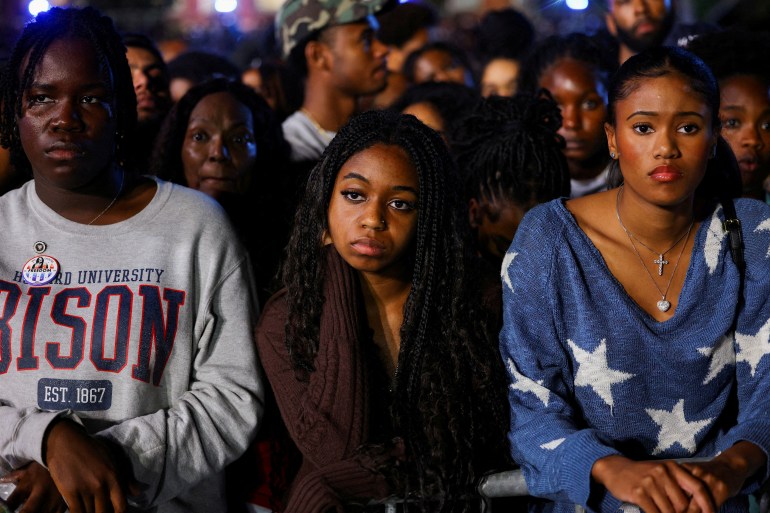The pre-election predictions were clear: The contest between former President Donald Trump and Vice President Kamala Harris would be decided by the tiniest of margins.
But the final result of the US presidential election has seemingly defied those forecasts, with former President Donald Trump winning both the popular vote and the Electoral College comfortably.
So how badly has Harris done, and where did her campaign go wrong — so wrong that Trump could end up with the largest popular vote margin of victory for any Republican candidate in 36 years?
What was the outcome of the US election?
Trump has already won 295 Electoral College votes while Harris stands at 226. The majority mark is 270.
Although ballots for voting precincts in many swing states have not been called, including Michigan, Wisconsin, Philadelphia, Georgia, Nevada and Arizona, Trump has already been declared winner in five of them, because the lead he enjoys there exceeds the votes still to be counted.
Nevada and Arizona are the only two states that have not yet been called, but pollsters now predict Trump should win both — which would put Trump’s final Electoral College count at 312 votes.
Trump has also already won nearly 73 million votes, compared to 68 million votes for Harris.
Prior to this election, George W Bush was the last Republican to win the popular vote 20 years ago. Bush won 62,040,610 votes and 286 electoral votes in comparison to Democratic nominee John Kerry, who secured 59,028,444 votes and 251 electoral votes.
The last time a Republican won the popular vote by a larger margin than the one Trump currently enjoys was Bush’s father, George HW Bush, in 1988.
Harris appears poised to lose all seven swing states. And the margin of her victory in decidedly “blue” or Democrat-leaning states has also shrunk. In the 2020 US election, Biden was up 16 points against Trump in New Jersey, for instance, whereas Harris won the state by only 5 points this time — that’s almost within the margin of error for many pollsters.
She has also underperformed in neighbouring New York state, another deep blue stronghold. With 97 percent of votes counted, Harris has won by 11 percentage points. In 2020, Biden beat Trump in New York by 23 percentage points.
So how did Harris’s campaign collapse?

A late start?
More than two years ago, in 2022, a New York Times poll found that only 26 percent of Democrats wanted their president, Joe Biden, to represent the party again in the 2024 race. In other words, three out of four Democrats were calling for a new leader.
Yet, following the party’s success in the midterm elections that year, the Democrats decided to back Biden as their candidate for 2024.
It was only after a disastrous debate performance against Trump in June 2024 that Biden pulled out of the race the following month. Harris had only four months to prepare and run her campaign. Despite some calls for a primary process to elect the party’s new face, most heavyweight Democratic Party figures — including former President Barack Obama and wife Michelle — quickly endorsed Harris.
She was eventually nominated without a primary. That meant that Harris was never tested this year in a contest against other presidential aspirants from her own party — which had a fait accompli thrust upon it.
Mixed messaging: Different from Biden — or not?
Harris had to pick up the campaign baton in July from a deeply unpopular president, whose ratings had been hovering in the low 40s. After the Trump-Biden debate that pushed the Democratic Party to change its nominee, Trump led Biden 49 percent to 43 percent in approval ratings, according to a New York Times/Siena College poll.
The vice president tried to distinguish her campaign from Biden’s, promising that she was “turning the page” and that “we are not going back”. However, when pushed in interviews or on TV shows about Bidenomics — Biden’s economic policies — in particular, she struggled to differentiate herself from the president.
When asked whether there is anything she would have done differently than Biden over the past four years in an interview on The View in October, Harris responded, “There is not a thing that comes to mind in terms of — and I’ve been a part of most of the decisions that have had impact.”
This, at a time when approval of the economy is at a low, and inflation is yet to come down to pre-COVID-19 levels.
“There is not a thing that comes to mind” became a phrase that the Trump campaign would use in advertisements to portray Harris as an extension of Biden’s legacy, with accompanying taglines like “prices still rising”, and “illegal crossings surge”.
But Harris also lost voters among some key constituencies that had long backed the Democratic Party, even compared to Biden. And Trump’s ability to shave away voters from Harris while bringing them over to his Make America Great Again (MAGA) coalition, proved to be a winning strategy.
Lost voters: Arab and Muslim Americans
Harris lost ground with Arab American and Muslim voters because of the Biden administration’s full-throated support for Israel’s brutal war on Gaza and Lebanon. This culminated in the emergence of the Abandon Harris campaign that was endorsed by Green Party candidate Jill Stein.
According to the Council on American-Islamic Relations (CAIR), the largest Muslim advocacy group in the US, by the time of the election, Stein led with 42 percent of the Muslim vote in the US with Harris at 41 percent and Trump at 10 percent.
On Election Day, this trend would bear fruit for Trump. Dearborn, Michigan, which has one of the highest concentrations of Arab-Americans in the US, voted 47 percent for Trump, 28 percent for Harris, and 22 percent for Jill Stein, according to numbers reported by the city clerk for that district.

Black voters shifting away
Black voters have been the single most dedicated voting bloc for the Democratic Party since the election of Franklin D Roosevelt in 1932.
Expectations for Black support were high for Harris, being the first mixed-race candidate of African and Indian American heritage in the election. She was also in the running to become the second African American to make it to the White House.
But she faced headwinds.
A Gallup poll last year showed that the proportion of Black adults in the US who consider themselves Democrats had decreased from 77 percent in 2020 to 66 percent.
In the current election, Black voters supported Trump at levels not seen since George W Bush’s election in 2000.
According to exit polls from the Associated Press, Trump won 20 percent of the Black vote this time. He won 13 percent of the community’s vote in 2020 and 8 percent in 2016.
In Pennsylvania, a crucial swing state in the 2024 election, Harris lost 3 percentage points in Black support compared to 2020, with 89 percent versus Biden’s 92 percent. Trump would gain 3 points, from 7 percent in 2020 to 10 percent this time.
In Wisconsin, the numbers were even more stark. Harris’s support among Black voters fell by 15 percentage points — 77 percent versus 92 percent for Biden. Trump’s voter share soared from 8 percent in 2020 to 21 percent in 2024.
“Frustrations are being made clear in this rising percentage of Black voters [who are] taking a different look at the Republican Party in general, and are exploring some curiosities with Trump, despite his racial baggage,” said Adolphus Belk, a political science professor at Winthrop University in South Carolina, referring to a string of comments and actions by Trump that have bee criticised as racist over the years.
What happened to the Latino vote?
Harris also lost support among Latino voters. Exit polls revealed a substantial 14 percentage-point increase in Trump’s support among this demographic compared to the previous presidential election in 2020.
The economy was the number one concern among Latino voters. Juxtapose these concerns with many seeing the economy lagging under Biden-Harris, and the vice president was always facing an uphill battle.
Latino voters, especially those in older age groups, were predominantly concerned with rising inflation rates, escalating healthcare expenses, and the increasing cost of housing, which took precedence over broader issues, according to a recent AP survey.
Meanwhile, the Democratic campaign emphasised themes such as democratic values, reproductive rights, and immigration policy.

What about women voters?
Women voters, a key part of the Harris campaign coalition, were anticipated to show heavy support for Harris at the polls on Election Day. A targeted advertising campaign urged conservative women to cast their ballots for Harris. Moreover, polls indicated that Harris maintained a substantial 20-point advantage over Trump on the issue of abortion rights.
Trump has consistently taken credit for the Supreme Court’s June 2022 verdict overturning Roe v Wade, the 1973 judgment that made abortion a national right. Three conservative appointments to the court by Trump had enabled the 2022 decision.
However, early national exit polls revealed that Harris secured the support of 54 percent of women voters, falling short of Biden’s performance in 2020 when he garnered 57 percent of the female vote.
But surveys before the election, and exit polls after the voting, both showed that women in the US rated inflation and other concerns about the economy as the most important issue before them — much more than abortion rights.
Harris lost the blue wall
The traditionally Democratic “blue wall” states of Michigan, Pennsylvania, and Wisconsin unexpectedly shifted to Republican control in the 2024 US presidential election, paving the way for Donald Trump’s triumph over Vice President Kamala Harris.
This mirrored Trump’s 2016 campaign strategy, when he penetrated the blue wall, rather than the 2020 election in which Joe Biden successfully recaptured these crucial swing states for the Democratic Party.
In Michigan, Trump eked out a win with a razor-thin margin of 1.4 percentage points. Pennsylvania proved slightly more decisive, with Trump winning by three percentage points. Wisconsin delivered the closest contest, where Trump won by just over one percentage point.
These aren’t the only swing states Trump won. Trump appears poised to win all swing states, totalling 93 electoral votes.
- Pennsylvania: 19 electoral votes
- North Carolina: 16 electoral votes
- Georgia: 16 electoral votes
- Michigan: 15 electoral votes
- Arizona: 11 electoral votes
- Wisconsin: 10 electoral votes
- Nevada: 6 electoral votes
The blue wall’s collapse made a pathway to victory impossible for Harris. With that, the game was over.
